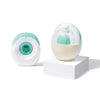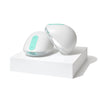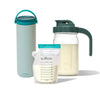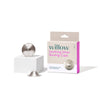Quick Answer: Getting the right flange size is key for comfort, let-down, and milk output when using a wearable pump—measure your nipple diameter, choose a flange or insert 1–3 mm larger, and recheck if you notice discomfort or reduced output.
What Is a Breast Pump Flange (and Why Size Matters)
A breast pump flange, also called a breast shield, is a cone-shaped funnel that fits over your nipple and areola to create suction for milk expression. Because every mom’s nipples are different (even from one breast to the other), flange sizes vary to ensure a proper fit.
Finding the right flange size is essential for both comfort and milk output. A snug, well-fitted flange provides the best suction, triggering the oxytocin response that helps you achieve letdown and efficient milk flow. If the flange is too large, you may experience weak suction and incomplete emptying. If it’s too small, the nipple can rub against the tunnel, leading to soreness, compressed ducts, and reduced supply.
“Oxytocin is blocked by pain and fear,” explains pediatrician Dr. Laurie Jones. “If your flanges don’t fit well, your body may limit or delay letdown.”
Since wearable breast pumps rely on a tight seal to function properly, they often require a slightly snugger fit than traditional pumps. Measuring regularly and adjusting as your body changes helps maintain both comfort and efficiency.
How to Measure Your Nipple Size (and Know What Flange Insert You Need)
Getting the right flange size starts with accurately measuring your nipple. This ensures a comfortable fit, proper suction, and better milk flow. Since your nipple size can change throughout your breastfeeding journey, plan to measure more than once.
When to Measure
-
Expectant mothers: Measure before your sixth month of pregnancy if you’d like an early estimate. Nipples often enlarge later in pregnancy, so this gives a useful starting point.
-
After delivery or hospital sizing: Re-measure around 6–8 weeks postpartum, once your milk supply stabilizes and swelling subsides.
-
Ongoing: Recheck any time you notice discomfort, pain, or a sudden drop in milk output. Nipples can fluctuate slightly in size based on time of day, temperature, or hormonal shifts.
Measurement Methods
-
Cut-out sizing tool: Use the printed circles from your Willow kit or download a sizing guide. Slide each circle over your nipple until it fits snugly at the base without pinching or compressing tissue. The circle that fits comfortably all the way down indicates your size.
-
Tape or ruler method: Stimulate your nipple gently to mimic a pumping state, then use a soft measuring tape or small ruler to measure the diameter across the base (from one side of the nipple to the other, excluding the areola). Write this number down in millimeters for accuracy.
-
Smartphone app: If you don’t have a measuring tool, use a nipple measurement app on iOS or Android. Align your nipple with the app’s on-screen guide, ensuring the edges match the measurement markers in millimeters.
-
Always measure both nipples separately, since many moms find one breast is slightly larger than the other. If your measurements fall between two sizes, start with the smaller insert for a snug fit and adjust if you feel discomfort or see lower output.
Flange/Insert Sizing Chart
Most moms using Willow find a flange 1-3 mm larger than their measured nipple works best (0-2 mm addition if using Willow 360).
|
Measured Nipple Size |
Willow Recommended Size Flange / Insert |
|
9-11mm |
13mm insert in 24mm flange |
|
12-13mm |
15mm insert in 24mm flange |
|
14-15mm |
17mm insert in 24mm flange |
|
16-17mm |
19mm insert in 24mm flange |
|
18-20mm |
21mm flange |
|
21-23mm |
24mm flange |
|
24-26mm |
27mm flange |
Tip: If you’re between sizes, sizing down often gives better comfort. If you measure > 25 mm and feel rubbing, try the 27 mm flange with nipple-safe lubricant.
Signs of a Good Fit vs a Poor Fit
-
Good fit: snug and comfortable, your nipple is centred, milk flows well, and you feel no pinching.
-
Poor fit: discomfort, nipple rubs against tunnel, flow drops, you may develop plugs or soreness.
If you feel pain, see nipple blanching, or notice reduced output, size may be wrong—or pump parts (duckbill, diaphragm) may need replacing.
Troubleshooting and Experimenting
Fit can depend on more than size—elasticity, breast tissue, and even how you wear your bra matter.
-
Try an insert if your flange feels too loose.
-
Give your body one week to adapt to a new size before switching again. Changing too often can confuse your let-down reflex and reduce output.
-
Ensure your pump is aligned properly, and that your bra supports the device snugly.
When to Seek Help from a Lactation Expert
Consider consulting an IBCLC or Certified Lactation Counselor if you:
-
Struggle to measure or fit at home
-
Feel persistent pain or discomfort
-
Notice a sudden drop in milk volume despite proper fit
Many Willow users can book a free sizing coaching session with a Willow Mom Coach expert.
Achieving Comfort & Efficiency: Final Checklist
-
Remember: wearables require a snugger fit than traditional pumps.
-
Measure your nipple diameter; don’t assume the default flange is right.
-
Expect your size to change—measure again if output or comfort changes.
-
Inserts can help refine the fit (for moms measuring < 21 mm).
-
If the fit works and output is good, there’s no need to swap sizes—comfort wins.
Did You Know Nipples Vary in Size Throughout Your Pumping Journey?
-
Nipple fact #1: Nipples can change size from morning to night, before and after feeding, and throughout your breastfeeding journey. They’re magical (and mercurial!) like that.
-
Nipple fact #2: Elasticity can impact sizing. Some nipples stretch wider, while some expand longer. Elasticity can also change depending on breastfeeding duration. We recommend elastic moms to use as snug an insert size as possible to prevent their nipples from being pulled too far into the flange and mushrooming.
-
Nipple fact #3: All moms require different levels of stimulation to trigger a letdown, and the letdown reflex is a trained response. This is why experimenting with multiple sizes is a good idea if you’re struggling to find a comfortable fit that results in optimal output.
FAQs on Flange Sizing for Wearable Pumps
-
What is a breast pump flange and why does size matter?
A flange is the part that fits over your nipple/areola to create suction; the correct size prevents discomfort and ensures effective milk removal. -
How do I measure my nipple size for a flange?
Measure the diameter of your stimulated nipple before or at least one hour after pumping using a tool, app or tape; then choose a flange/insert slightly larger for best fit. -
How often should I re-measure my nipple size?
Measure anytime your output drops, you feel pain during pumping, or approximately every few months—nipples change due to supply, time of day, and postpartum changes. -
What if I’m between sizes?
If you fall between sizes, consider sizing down for a closer fit; monitor comfort and flow for one week before adjusting again. -
Will a poor-fitting flange damage my supply?
Yes—too large or too small a flange impacts stimulation and breast emptying, which can reduce milk output and lead to discomfort or blocked ducts over time.
Tags Used





